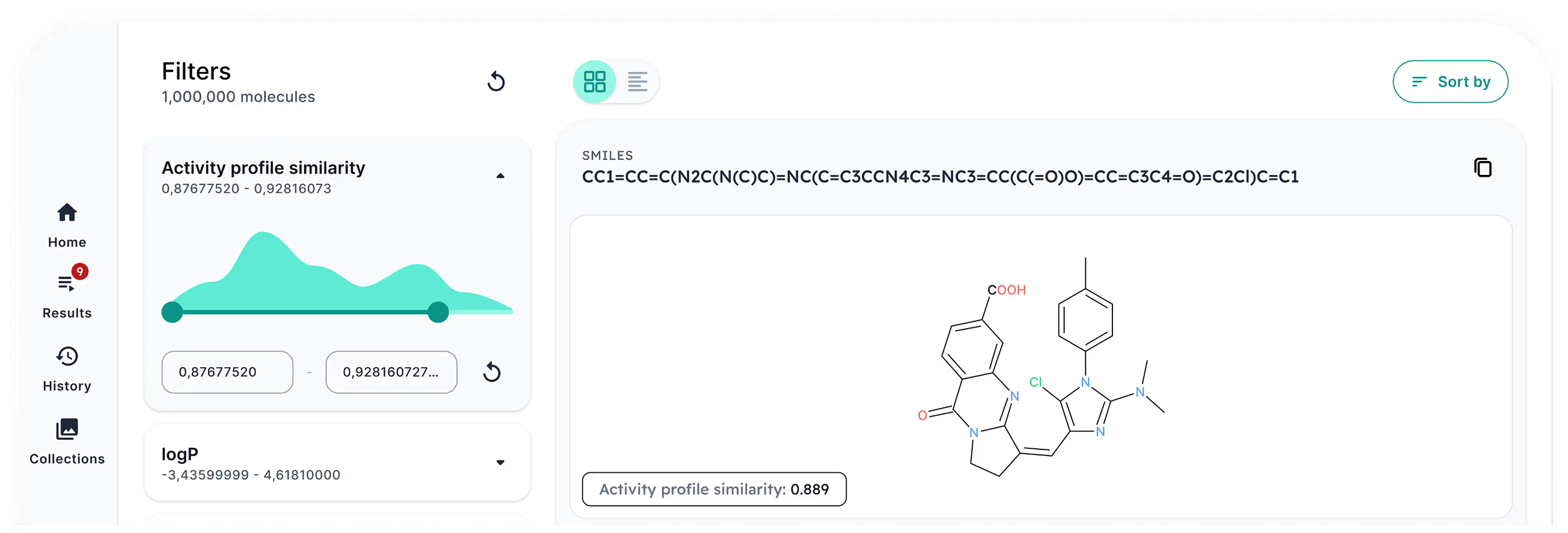VEGFR3 (FLT4)
Program co-owned - target ID by analysis of tumor samples from cancer patients done by our partner Oncobox.
Our AI platform finds and prioritizes novel ligands for your protein target, progressing from hit identification to lead optimization with measurable potency gains each round.


Our process is designed for speed and efficiency, delivering high-quality, experimentally validated hits through a seamless, three-step workflow. We partner with you through multiple iterations, covering the entire journey from initial Hit ID to Hit-to-Lead optimization.
Submit your protein target securely. No 3D structure required: our sequence-based B2 model can operate from the amino acid sequence alone.
We search billion-scale vendor libraries (e.g., Enamine REAL 75B+) or your in-house collections
Within one week, you receive a curated, purchasable hit list with an expected hit rate of ~5%. You validate in your lab — and iterate with us to refine potency, selectivity, novelty and ADMET properties.
Bioptic platform performs ultra-large virtual screening and returns a ranked, purchasable hit list for your target.
BIOPTIC B1, published in the Journal of Chemical Information and Modeling, uses a transformer-based architecture to deeply learn molecular structures.
It enables ultra-high-throughput screening, evaluating billions of molecules in minutes. B1 excels at scaffold hopping and uncovering novel chemotypes, even with limited ligand data. For the challenging LRRK2 target, it discovered new ligands with nanomolar potency from a 40-billion-molecule library.
BIOPTIC B2 tackles novel targets without known binders or 3D structures. Using only the amino acid sequence, it bypasses crystallography and homology models, unlocking previously “undruggable” proteins.
Its capabilities were validated in the PLUMBER benchmark on Polaris and presented at Stanford SDDS 2025.
BIOPTIC B3 is our evolving suite of specialized models for ADMET property predictions, built through leading ML competitions and academic collaborations.
From the LeashBio BELKA challenge to the Polaris ADME benchmark, this competition-driven innovation keeps our platform at the cutting edge, ready for the most complex drug discovery problems.
Our technology has been validated on some of the most challenging targets in drug discovery, delivering novel, potent, and selective molecules. These aren't just theoretical wins; they are peer-reviewed, published, and partnered successes.

Program co-owned - target ID by analysis of tumor samples from cancer patients done by our partner Oncobox.
TNIK is a novel target* for obesity (> $100B market), fibrosis, anti-aging.
LRRK2 (G2019S) Inhibitors for Parkinson’s disease. Promising target for Parkinson’s disease (> $5B market). Still no FDA-approved drug targeting LRRK2.
We measure our success by the results we deliver to our partners. The Bioptic Pipeline is engineered not just for theoretical accuracy, but for real-world, lab-validated performance. Our metrics speak for themselves.
Our platform can screen all 75 billion Enamine REAL Space compounds in a single day, leaving no stone unturned in the search for your ideal molecule.
From target submission to hit list delivery, our streamlined process takes just one week, letting you move faster than ever in drug discovery.
Our AI-driven approach boosts efficiency, with an average hit rate of ~5%, increasing your chances of finding meaningful starting points and saving time and resources on validation.
We consistently deliver sub-micromolar hits from fewer than 200 selected compounds, demonstrating the precision of our platform.
By incorporating your experimental data each round, our models adapt — yielding up to 4× potency improvements between screenings for targets like LRRK2 and FLT4.
Explore our peer-reviewed foundational paper on BIOPTIC B1 and its breakthrough application to LRRK2.
A better starting point leads to a better drug. We provide access to an unparalleled diversity of chemical matter by screening the largest commercially available and make-on-demand libraries in the world. This massive scale increases the probability of discovering truly novel scaffolds with superior properties.





We believe in transparency and scientific rigor. We actively publish our research in top-tier, peer-reviewed journals and present our findings at leading industry conferences. Our work is validated by the scientific community and trusted by our partners.
Peer-reviewed milestone. Our JCIM article shows how BIOPTIC B1 searched 40B compounds and delivered novel LRRK2 binders for Parkinson’s in weeks—not years, including sub-micromolar hits.
AI molecular search engine paired with RNA sequencing analysis to develop potent and selective VEGFR-3 inhibitors.
Bioptic -- A Target-Agnostic Potency-Based Small Molecules Search Engine
Overview of BIOPTIC B1/B2/B3 Scientific Modeling Layer presented at the Stanford Drug Discovery Symposium 2025
Venture creation firm that builds and funds a new generation of biotechnology companies.
”Our early work with OPTIC’s B1 and B2 models showed real promise in integrating AI into drug discovery. We look forward to seeing how the BIOPTIC agentic AI platform will further connect our scientific discoveries to strategic business insights, providing a powerful edge in our venture creation strategy”
Bioptic runs ultra-large virtual screening and hit prioritization for your protein target and delivers a ranked, purchasable hit list for your lab/CRO—accelerating Hit ID → Hit-to-Lead.
Often just the amino-acid sequence. B2 works sequence-only. If you have known ligands, B1 leverages them. No crystal or homology models required.
B1 (ligand-based) explores billion-scale libraries; B2 ranks binders directly from sequence; B3 filters ADMET/PK, novelty, synthesizability—yielding clean, order-ready plates.
About one week to your first prioritized, purchasable list.
Throughput up to ~75B compounds/day across vendor spaces (e.g., Enamine REAL, OnePot, eMolecules eXplore) and/or your proprietary library.
Typically test ~100 compounds/round with ~5% expected hit rate (multiple hits at IC50/Kd ≤ 10 μM). Iterations often deliver ~4× potency gains toward sub-µM.
Your CRO or your in-house laboratory. Bioptic supplies order-ready shortlists and supports iterative refinement as assay results return.
A deliverable package: (1) ranked list with metadata (predicted potency, novelty, ADMET flags, vendor links); (2) CSV/SDF for ELN/LIMS & ordering; (3) iteration plan (next-round expansion/refinement).
Similarity limits (e.g., ECFP4 Tc thresholds, Bemis–Murcko diversity, substructure alerts)
Peer-reviewed science (JCIM), public case studies (LRRK2 potency; TNIK potency on a hot target; FLT4 selectivity), measurable outcomes (~5% hit rate, ~4× gains), traceable/evidence-linked outputs, secure deployment (incl. on-prem).
Projects start at $50,000 (initial screening + prioritized hit list). Packages with 3–4 iterations start at $100,000 (screen → test → refine) to progress from Hit ID toward leads.
Share your sequence (± known ligands), assay constraints and success criteria. We align libraries & ADMET filters and deliver your first prioritized set in ~1 week.
Whether you're a researcher, potential partner, or just curious about what we're building, drop us a message. Explore how we can push the boundaries of science and discovery.
